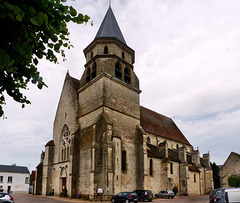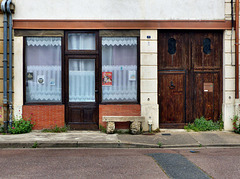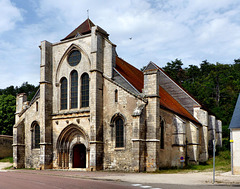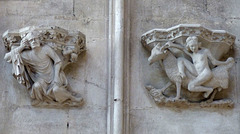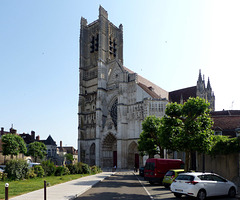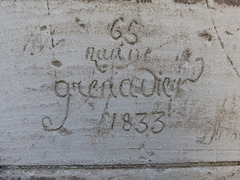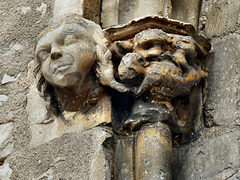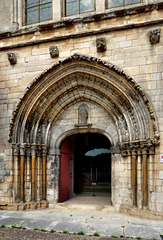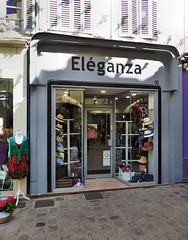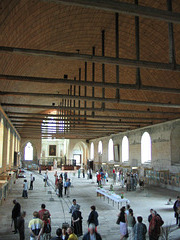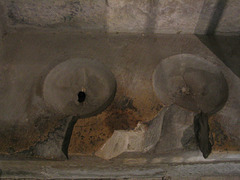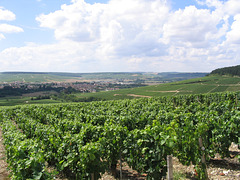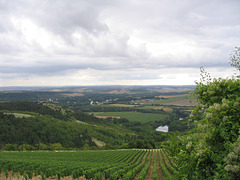
Bourgogne-Franche-Comté
Bourgogne-Franche-Comté created was created by the 2014 territorial reform of French regions, from a merger of Burgundy and Franche-Comté
Prémery - Saint-Marcel
| |
|
|
Saint-Marcel serves the parish today. It was erected within the 13th century as a collegiate church. The collegiate of Saint Marcel was founded in 1196, it has nine canons.
Prémery - STOP AMAZON
Gy-l’Évêque - Saint-Phal
| |
|
|
The territory was owned by the bishops of Auxerre since the reign of Charles the Bald. The bishops had a stone house and a chapel built and vines planted.
The large church of Gy l'Evêque was erected in the 13th century. The facade from that time still exists. During the Wars of Religions in the 16th century, the church was burnt down and collapsed. It got rebuilt on the basis of the old building. It fell into negligence over the centuries and collapsed again in 1924.
The parish priests organized a basic rebuilding financed by the local "Association du Christ aux orties". The walls were restored and in 1989 the nave got roofing.
Auxerre - Saint-Étienne d'Auxerre
| |
|
|
Auxerre was a Gallo-Roman centre, then called Autissiodorum. It became the seat of a bishop already in the 3rd century. In the 5th century, it received a cathedral.
Wine cultivations starting from the twelfth century made Auxerre a flourishing town. Auxerre suffered during the Hundred Years' War and the Wars of Religion. In 1567 it was captured by the Huguenots, and many of the Catholic edifices were damaged.
The Cathédrale Saint-Étienne is actually the 5th on the spot.
The erection started in 1215 around the same time when the building of the cathedrals in Reims and Amiens started. The church was erected over a still existing crypt from the previous building (~ 1030). The choir was completed in 1235. At the same time, the construction of the facade began.
The sculptured portal is dated to around 1320.
I have been here a couple of times and have uploaded already many photos, so this time I will cut it down to just a few.
The three tympana of the facade are pretty damaged. Seen on the left side of the lintel is a "Weighing of the Souls". The "bad ones" go directly into the "Mouth of Hell" to suffer while the "good ones" are carried away by angels.
Auxerre - Saint-Étienne d'Auxerre
| |
|
Auxerre was a Gallo-Roman centre, then called Autissiodorum. It became the seat of a bishop already in the 3rd century. In the 5th century, it received a cathedral.
Wine cultivations starting from the twelfth century made Auxerre a flourishing town. Auxerre suffered during the Hundred Years' War and the Wars of Religion. In 1567 it was captured by the Huguenots, and many of the Catholic edifices were damaged.
The Cathédrale Saint-Étienne is actually the 5th on the spot.
The erection started in 1215 around the same time when the building of the cathedrals in Reims and Amiens started. The church was erected over a still existing crypt from the previous building (~ 1030). The choir was completed in 1235. At the same time, the construction of the facade began.
The sculptured portal is dated to around 1320.
I have been here a couple of times and have uploaded already many photos, so this time I will cut it down to just a few.
An ewe
Auxerre - Saint-Étienne d'Auxerre (PiP)
| |
|
|
|
Auxerre was a Gallo-Roman centre, then called Autissiodorum. It became the seat of a bishop already in the 3rd century. In the 5th century, it received a cathedral.
Wine cultivations starting from the twelfth century made Auxerre a flourishing town. Auxerre suffered during the Hundred Years' War and the Wars of Religion. In 1567 it was captured by the Huguenots, and many of the Catholic edifices were damaged.
The Cathédrale Saint-Étienne is actually the 5th on the spot.
The erection started in 1215 around the same time when the building of the cathedrals in Reims and Amiens started. The church was erected over a still existing crypt from the previous building (~ 1030). The choir was completed in 1235. At the same time, the construction of the facade began.
The sculptured portal is dated to around 1320.
I have been here a couple of times and have uploaded already many photos, so this time I will cut it down to just a few.
Goat riders are strange icons one can find all over medieval Europe.
Auxerre - Saint-Étienne d'Auxerre
| |
|
|
|
Auxerre was a Gallo-Roman centre, then called Autissiodorum. It became the seat of a bishop already in the 3rd century. In the 5th century, it received a cathedral.
Wine cultivations starting from the twelfth century made Auxerre a flourishing town. Auxerre suffered during the Hundred Years' War and the Wars of Religion. In 1567 it was captured by the Huguenots, and many of the Catholic edifices were damaged.
The Cathédrale Saint-Étienne is actually the 5th on the spot.
The erection started in 1215 around the same time when the building of the cathedrals in Reims and Amiens started. The church was erected over a still existing crypt from the previous building (~ 1030). The choir was completed in 1235. At the same time, the construction of the facade began.
The sculptured portal is dated to around 1320.
I have been here a couple of times and have uploaded already many photos, so this time I will cut it down to just a few.
Auxerre - Saint-Germain d’Auxerre
| |
|
Auxerre was a Gallo-Roman centre, then called Autissiodorum. Here the Via Agrippa crossed the Yonne river. It became the seat of a bishop already in the 3rd century. In the 5th century, it received a cathedral.
Wine cultivations starting from the twelfth century made Auxerre a flourishing town. Auxerre suffered during the Hundred Years' War and the Wars of Religion. In 1567 it was captured by the Huguenots, and many of the Catholic edifices were damaged.
The former abbey goes back to an oratory erected by Bishop Germain for the relics of St. Maurice. It then became the Bishop´s burial ground. About the year 500, it was rebuilt as a basilica, by Queen Clotilda, wife of Clovis.
In 850 Abbot Conrad, brother-in-law of Louis the Pious, had a crypt built. Attached to the crypt was a circular oratory. Conrad's nephew, Emperor Charles the Bald, was present at the translation of the relics of Germain (Germanus).
In 1927, beneath the 17th-century frescoed plaster walls of the crypt, were discovered ninth-century wall frescoes, the only surviving large-scale paintings of their date in France.
During the Revolution, several bays of the nave were demolished and the secularized abbey was used as a hospital.
I had seen the frescoes some years ago. They are fantastic, but it is not allowed to take photographs. This early morning the abbey/museum was still closed, so I just took some photos of the graffiti.
Gy-l’Évêque - Saint-Phal
| |
|
The territory was owned by the bishops of Auxerre since the reign of Charles the Bald. The bishops had a stone house and a chapel built and vines planted.
The large church of Gy l'Evêque was erected in the 13th century. The facade from that time still exists. During the Wars of Religions in the 16th century, the church was burnt down and collapsed. It got rebuilt on the basis of the old building. It fell into negligence over the centuries and collapsed again in 1924.
The parish priests organized a basic rebuilding financed by the local "Association du Christ aux orties". The walls were restored and in 1989 the nave got roofing.
Does the poor soul in the devil´s jaws try to pull on the lady´s braeds?
Gy-l’Évêque - Saint-Phal
| |
|
|
The territory was owned by the bishops of Auxerre since the reign of Charles the Bald. The bishops had a stone house and a chapel built and vines planted.
The large church of Gy l'Evêque was erected in the 13th century. The facade from that time still exists. During the Wars of Religions in the 16th century, the church was burnt down and collapsed. It got rebuilt on the basis of the old building. It fell into negligence over the centuries and collapsed again in 1924.
The parish priests organized a basic rebuilding financed by the local "Association du Christ aux orties". The walls were restored and in 1989 the nave got roofing.
The portal
Gy-l’Évêque - Saint-Phal
| |
|
|
The territory was owned by the bishops of Auxerre since the reign of Charles the Bald. The bishops had a stone house and a chapel built and vines planted.
The large church of Gy l'Evêque was erected in the 13th century. The facade from that time still exists. During the Wars of Religions in the 16th century, the church was burnt down and collapsed. It got rebuilt on the basis of the old building. It fell into negligence over the centuries and collapsed again in 1924.
The parish priests organized a basic rebuilding financed by the local "Association du Christ aux orties". The walls were restored and in 1989 the nave got roofing.
Auxerre - ELÉGANZA
Tonnerre
| |
|
..inside the Hôtel-Dieu de Tonnerre. - This was built as a hospital for the pilgrims heading to Vezelay
and from there on to Santiago between 1293 and 1296. The building was financed by Marguerite de Bourgogne. It covers 4500 m² and is one of the largest and oldest of such "hospitals" in France.
Tonnerre
Tonnerre
| |
|
|
...the Fosse Dionne is for sure one of the nicest wash-houses in the whole of France. Actually there is a mythic secret. Deep inside lives a gaelic godess, who from time to time...
Chablis
| |
|
..best weather, walking through the vineyards. The town of Chablis can already be seen, so all around me is probably "Chablis 1er Cru".
Chablis
| |
|
...of the entrance doors of the church in Chablis. For centuries riders have nailed old horseshoes onto it. Maybe they had drunken too much of the white wine, produced here..........
Irancy
Jump to top
RSS feed- Latest items - Subscribe to the latest items added to this album
- ipernity © 2007-2024
- Help & Contact
|
Club news
|
About ipernity
|
History |
ipernity Club & Prices |
Guide of good conduct
Donate | Group guidelines | Privacy policy | Terms of use | Statutes | In memoria -
Facebook
Twitter

